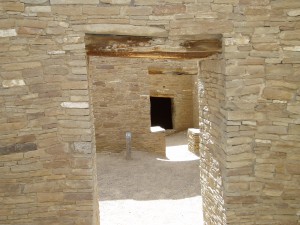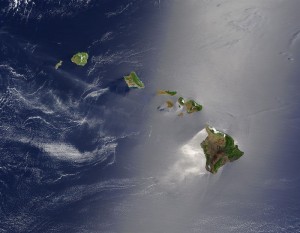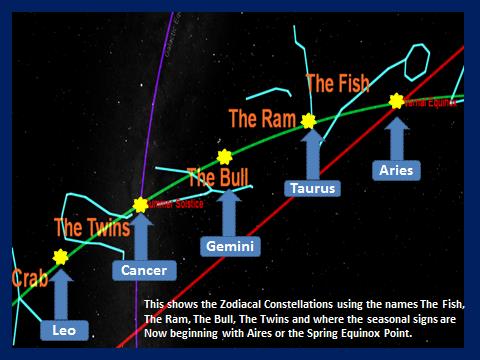Evidence for the Fall from Equality
The central thesis of this article can be illustrated with two examples:
Chaco Canyon, New Mexico
Living for many years in the Mimbres River Valley and conducting astrological vision quest groups in Chaco Canyon awakened my curiosity about what happened to the Chaco culture, otherwise known as the Anasazi. Inspired by the work of Stephen Lekson, in his book The Chaco Meridian (1999), this is what seems to have happened: An egalitarian and gylanic Neolithic culture lived throughout the western and southwestern United States. Their petroglyphs and other remains go back 10,000 years. Interestingly, the more ancient (called archaic) style of petroglyphs are the most complex and abstract.
 As the weather patterns changed and increasingly became drier, groups of these early Native Americans moved south into the area around Chaco Canyon. At approximately the same time, Aztecs were heading north from Mexico along the same longitudinal line and and they met at Chaco. The Aztec culture was highly stratified and completely class, caste, and hierarchy based.
As the weather patterns changed and increasingly became drier, groups of these early Native Americans moved south into the area around Chaco Canyon. At approximately the same time, Aztecs were heading north from Mexico along the same longitudinal line and and they met at Chaco. The Aztec culture was highly stratified and completely class, caste, and hierarchy based.
The integration of these two very different cultures did produce many remarkable achievements including great ceremonial structures, advanced urban planning, and an extensive system of roads. But their was a growing gap between the priest/elites and the commoners.
In addition, ecological disaster wreaked havoc upon the land as resources were plundered to support the elite strata of society. Rainfall continued to diminished and soon the water wars began. Evidence shows that eventually the ‘Chaco Project’ was abandoned. Many people today are still led to wonder: “What happened to the Anasazi?” This is not unlike the question “Where did the Maya disappear to?”
In actual fact the Maya are still there, millions of them. And around the area of Chaco, so are the Anasazi. They gave up the hierarchical stratification and the big building projects, returning to something more resembling their gylanic and egalitarian roots. These people are today known as the Hopi, Pueblo, Zuni, Acama, etc.
Hawaii
 The story in Hawaii is similar, perhaps even more extreme. I lived in Hawaii for many years and was deeply influenced by [800px-Hawaje-NoRedLine] reading the insightful book Tales from the Night Rainbowand receiving teachings from several Hawaiian cultural practitioners.
The story in Hawaii is similar, perhaps even more extreme. I lived in Hawaii for many years and was deeply influenced by [800px-Hawaje-NoRedLine] reading the insightful book Tales from the Night Rainbowand receiving teachings from several Hawaiian cultural practitioners.
My current understanding of Hawaiian history is this: Historically, there was a so-called first migration from the Marquesas Islands near Tahiti. There is mythical evidence that the aboriginal Menehune peoples were in the Hawaiian Islands long before that. All accounts speak of a true land of Aloha that was very much like the gylanic, egalitarian, and pre-dominator past we are discussing here. Whilst there was royalty, it was not at a level high above the people. There was food for all and few warriors.
Around 1250, a banished would-be priest from Tahiti named Pa’au voyaged by water to Hawaii. Upon landing ashore, he noticed the bountiful abundance and the lack of warriors. He particularly noted, with scorn, how the royalty (known as the Ali’i) connected closely with the people and were not respected as gods. After observing Hawaii for a while, he took his canoe and sailed for Samoa. A few years later he returned to Hawaii with many war canoes and, you guessed it, took over.
He imposed a new priest-Ali’i class and he introduced human sacrifice. He instituted the Hawaiian system of Kapu with its extreme protocols of separating the Ali’i from the rest of the people. It is said that if you so much as looked into the eyes of an Ali’i, you could be put to death, becoming fodder for the human sacrifices at the ceremonial Heiau’s, which were soon rededicated to the god of war. It was even worse for the women.
It is no wonder that when the missionaries arrived, the Hawaiians heard a message of egalitarian love. Unfortunately, the message was only empty words.
An interesting anecdote worthy of mention here is that the Menehune are often described as the “little people”, i.e. midgets. In actuality the word simply meant “smaller in breath or power”. In other words, in the framework of winners and losers, they lost!
These events are similar to early events in Ireland. When the Thua da Danaan lost their battles to the patriarchal warrior Celtic invaders, they became not only the fairies, elves, and nature spirits of the land, but also the leprechauns or the “little people”.
There seems to be a pattern, even though these stories are not in our official “history”. With Chaco, few want to hear of its dark side. In Hawaii, many of the current ruling class have no interest in making the story of Pa’au, common knowledge, as they themselves derive many benefits that they have received from their claims of belonging to Pa’au’s bloodline.
Bloodlines
Closely connected with caste, class, and hierarchy is the subject of bloodlines. In alternative approaches to history, particularly among women’s spirituality groups and now even in the mainstream, there is a general awareness of the real Mary Magdalene and the bloodline of the Holy Grail. This includes the view that the Magdalene had children with Jesus and that this bloodline exists within the Merovigian Royal Bloodline, as well as being claimed by others.
I do love that Mary Magdalene has been reconstructed once again into a strong figure: she is the symbol of a priestess tradition that was certainly the equal of that which Jesus represented. That they were collaborators and equals and quite probably had a sexual relationship and children, how wonderful! But it’s the bloodline thing that often gets emphasized.
Why should anyone care about this? There is a growing skeptical view that sees the whole bloodline angle as being planted and perpetuated to justify elite groups or wannabe elite groups to enable them to have power and sanction their activities. Plus there is also the implied allurement that maybe you too have the bloodline, and therefore maybe you too could be one of us!
In response to all of this, I say: it is time the age of bloodlines, class, caste, and hierarchy be over.
The Aquarian Dispensation
In the early years of the development of the Shamanic Astrology paradigm (the 1970’s), I became aware of the idea of the Aquarian Dispensation. I actually do not remember the exact source of this teaching. Today, there exist today several more expositions of this doctrine which differ from what I learned about it back then. I found these by just searching for “Aquarian Dispensation” on the internet.
 The Aquarian Dispensation, as I understand it, remains a guiding principle of the Shamanic Astrology paradigm and the Shamanic Astrology Mystery School.
The Aquarian Dispensation, as I understand it, remains a guiding principle of the Shamanic Astrology paradigm and the Shamanic Astrology Mystery School.
It goes like this: There was a time on this planet (roughly 4000-6000 years back; it varies in different parts of the world) when an authentic royalty – a ruling elite that modeled for the rest of humanity the highest virtues that a human being could have – existed that were committed to serving the people. They may have had a specific bloodline.
No doubt they only married each other and didn’t mix with other bloodlines. There was much inbreeding, such as the marrying of one’s brothers, sisters, etc. As the Ages turned, first from Gemini to Taurus (6000-4000 B.C.) and later from Taurus to Aries (4000-2000 B.C.), the elite pharaohs, kings, queens, Brahmans, etc. knew that big change was coming, mainly due to the violent incursions of warlike patriarchal dominators and plunderers (sometimes known as Kargans or Aryans) bent on destroying their culture. They knew that whatever royalty there was in their bloodline would be lost.
However they also knew that this was intended to happen. The bloodlines were to be dispersed, to be spread to the whole of the human race. The wise ones knew that this was the time to let go of the ‘specialness’ of the elite bloodlines. They foresaw that after a quarter turn of the Great Year (6500 years) there would come the Aquarian Dispensation, when the spreading or distribution of the bloodline of infinity would be potentially extended to anyone and everyone, reaching the DNA of all. By way of reference, these mystery school teachings are part of the deeper layers of Leo and Aquarius.
The great wheel has now turned and the Aquarian Dispensation is upon us. We all carry the bloodline. We are all in this together. This is the time of eliminating false classes or hierarchies, no more castes or dominator programs. It is time for us to reconnect to our pre-patriarchal and pre-hierarchical gylanic and egalitarian ancient heritage, that is so much vaster and deeper than what has been delivered by the aforementioned triple aberration.
The Shamanic Astrology Mystery School is committed to a renaissance of gylany and an egalitarian world where men and women love and respect each other as collaborative allies and equals. Let us dream this as our future!
The next installment will explore the various theories on how and why the triple aberration happened.
SOURCE MATERIAL: With comments by Daniel Giamario
Gardiner, L. (1996). Bloodline of the Holy Grail: The hidden lineage of Jesus revealed. Fair Winds Press.
Many other books and websites also address a hypothetical sequence of lineal descendents of the historical Jesus and Mary Magdeline and related bloodline issues. If you really want to explore this further, from many perspectives, check out the profusion of web pages relating to the Dragon Family.
Hillman, J. (1997). The Soul’s Code: In Search of Character and Calling. Grand Central Publishing.
Besides being the best book I have ever read from an archetypal psychologist, this work really matches the Shamanic Astrology paradigm. In addition Hillman beautifully tackles and resolves the apparent conflict between Plato’s system and an egalitarian and equalitarian approach. Essential reading.
Lekson, S. (1999). The Chaco Meridian: Centers of Political Power in the Ancient Southwest. University of Colorado Boulder. An exploration of the meridian of 108W and many other controversies surrounding the Chaco culture.
Willis, K., & Lee, P.J. (1990). Tales From the Night Rainbow. Hawaii: Night Rainbow Publishing Co.
An oral history as told by Kaili’ohe Kame’ekua of Kamalo, Moloka’i, 1816-1931. Includes insights and descriptions of the original Hawaiian traditions, as well as the Pa’ao story and information about who the Menehune people were.


Leave a Reply